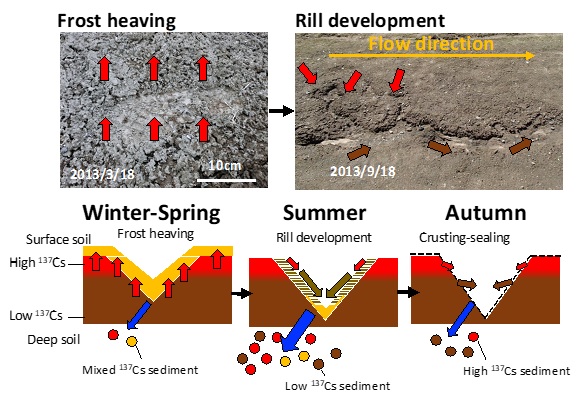Project Assitant Professor Yasunori Igarashi
February 26, 2021
This study investigated soil erosion from artificially bare soil and the amount of 137Cs released from the soil on mountain slopes in Fukushima. Freezing up destroys the structure of the soil surface and accelerates soil erosion from the soil surface. Therefore, it was found that 137Cs deposited on the surface layer was more selectively released from early spring to summer (Fig. 1). We consider that the eroded sediment will flow into the river and be transported downstream. In the future, we will continue our research with a view to the impact on rivers.

Figure 1: Conceptual diagram: Freezing in winter destroys the structure of the soil surface and selectively transports 137Cs from the surface soil surface during spring and summer.
In this study, we focused on 137Cs runoff due to soil erosion from seasonal change of soil surface condition, and revealed that the change of soil surface condition affects the concentration of 137Cs in the eroded sediment and the amount of 137Cs discharge.
This study is available online in January 2021.
Journal:Science of The Total EnvironmentTitle: Impacts of freeze-thaw processes and subsequent runoff on 137Cs washoff from bare land in Fukushima
URL: https://doi.org/10.1016/j.scitotenv.2020.144706
Authors:Yasunori Igarashia, Yuichi Ondab, Yoshifumi Wakiyamaa, Kazuya Yoshimurac, Hiroaki Katob, Shohei Kozukad, Ryo Manomee
*aInstitute of Environmental Radioactivity, Fukushima University
*bDepartment of Integrative Environmental Sciences, Faculty of Life and Environmental Sciences, University of Tsukuba
*cSector of Fukushima Research and Development, Japan Atomic Energy Agency
*dMinistry of the Environment
*eDisaster Prevention Technology Division, Geo-hazard & Risk Mitigation, Railway Technical Research Institute